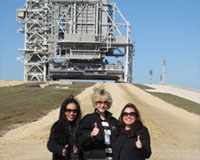 |
College Park MD (SPX) Jun 23, 2010 As you go about your day-to-day activities, tiny bubbles of nitrogen come and go inside your tissues. This is not a problem unless you happen to experience large changes in ambient pressure, such as those encountered by scuba divers and astronauts. During large, fast pressure drops, these bubbles can grow and lead to decompression sickness, popularly known as "the bends." A study in the Journal of Chemical Physics, which is published by the American Institute of Physics (AIP), may provide a physical basis for the existence of these bubbles, and could be useful in understanding decompression sickness. A physiological model that accounts for these bubbles is needed both to protect against and to treat decompression sickness. There is a problem though. "These bubbles should not exist," says author Saul Goldman of the University of Guelph in Ontario, Canada. Because they are believed to be composed mostly of nitrogen, while the surrounding atmosphere consists of both nitrogen and oxygen, the pressure of the bubbles should be less than that of the surrounding atmosphere. But if this were so, they would collapse. "We need to account for their apparent continuous existence in tissues in spite of this putative pressure imbalance," says Goldman. If, as is widely believed, decompression sickness is the result of the growth of pre-existing gas bubbles in tissues, those bubbles must be sufficiently stable to have non-negligible half-lives. The proposed explanation involves modeling body tissues as soft elastic materials that have some degree of rigidity. Previous models have focused on bubble formation in simple liquids, which differ from elastic materials in having no rigidity. Using the soft-elastic tissue model, Goldman finds pockets of reduced pressure in which nitrogen bubbles can form and have enough stability to account for a continuous presence of tiny bubbles that can expand when the ambient pressure drops. Tribonucleation, the phenomenon of formation of new gas bubbles when submerged surfaces separate rapidly, provides the physical mechanism for formation of new gas bubbles in solution. The rapid separation of adhering surfaces results in momentary negative pressures at the plane of separation. Therefore, while these tiny bubbles in elastic media are metastable, and do not last indefinitely, they are replaced periodically. According to this picture, tribonucleation is the source, and finite half-lives the sink, for the continuous generation and loss small gas bubbles in tissues. The article, "Free energy wells for small gas bubbles in soft deformable materials" by Saul Goldman was published on April 26,2010 in the Journal of Chemical Physics.
Share This Article With Planet Earth
Related Links American Institute of Physics Space Medicine Technology and Systems
 New Study Investigates Infection Of Human Cells In Space
New Study Investigates Infection Of Human Cells In SpaceCape Canaveral FL (SPX) Apr 05, 2010 In a first-of-its-kind experiment, the unique conditions of spaceflight will be used to examine how cells remain healthy or succumb to disease, particularly in the face of stress or damage. At 3:21 a.m. PDT on April 5, ASU Biodesign Institute researchers Cheryl Nickerson and her team, including Jennifer Barrila and Shameema Sarker, will see their latest experiment launched into low earth o ... read more |
|
| The content herein, unless otherwise known to be public domain, are Copyright 1995-2010 - SpaceDaily. AFP and UPI Wire Stories are copyright Agence France-Presse and United Press International. ESA Portal Reports are copyright European Space Agency. All NASA sourced material is public domain. Additional copyrights may apply in whole or part to other bona fide parties. Advertising does not imply endorsement,agreement or approval of any opinions, statements or information provided by SpaceDaily on any Web page published or hosted by SpaceDaily. Privacy Statement |